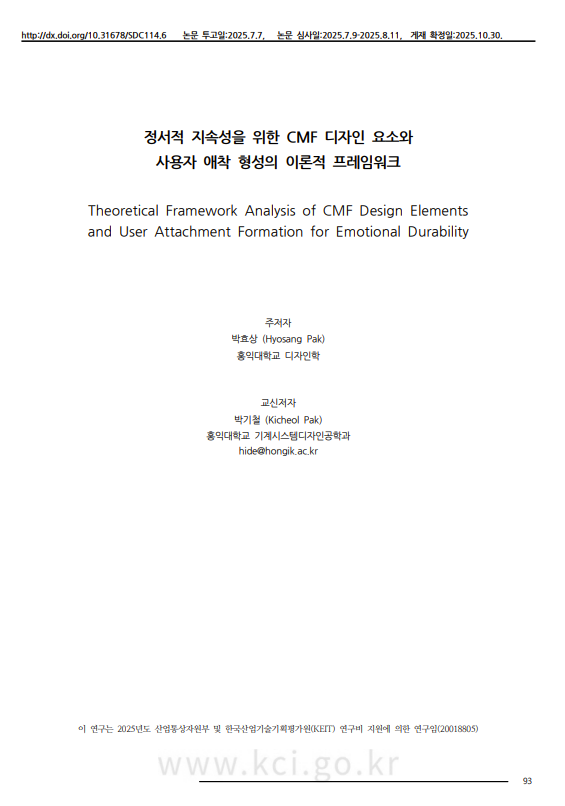통합 검색
통합 검색
- 작성자 hide
- 조회수 95

Topic: Theoretical Framework Analysis of CMF Design Elements and User Attachment Formation for Emotional Durability
This study investigates the emotional formation mechanism underlying Emotional Durability through theoretical discussion and case-based analysis, focusing on how CMF (Color, Material, Finishing) design elements contribute to the formation of user attachment. The research identifies Attachment as a core factor of emotional durability and examines how emotions are recorded and interpreted on the product surface through the interaction between makers and users. To frame this relationship, the study adopts the aesthetic perspectives of Wabi-sabi—which embraces imperfection and transience—and Material Culture of Design, which emphasizes the accumulation of meaning through repeated use and repair. These are integrated through the conceptual lens of Tabula Scripta, a metaphorical framework that views the surface as a “narrative layer” where emotions are inscribed over time.
Based on this framework, four hypotheses (H1–H4) were established according to the relational dynamics between makers and users. Each hypothesis was tested through the analysis of 22 design cases, including garments, ceramics, furniture, and everyday products, focusing on CMF attributes such as wear, crack, patina, repair, and discoloration. The findings reveal that emotional attachment does not arise merely from physical change but from the interpretive process through which surface traces become embodied memories and personal identity. When the maker and user are the same, repetitive use and maintenance create personal narratives that strengthen attachment. When they differ, users assign emotional meaning by interpreting or adding traces themselves.
The study conceptualizes the product surface as a “narrative layer” and constructs a process model consisting of six sequential stages: (1) creation and acquisition, (2) surface transformation, (3) sensory stimulation, (4) emotional internalization, (5) attachment formation, and (6) continued use and meaning accumulation. Through this process, attachment emerges not as a fleeting emotion but as a repeated affective structure mediated by temporal and material traces that connect memory and identity.
In conclusion, this study presents a structured mechanism by which CMF design elements mediate temporality, materiality, and sensory experience to generate emotional meaning. Attachment, understood as an emotion continually renewed through the material traces of time, contributes to product longevity and sustainable design practice. By redefining the product surface as an emotional record, this study proposes a new theoretical framework for emotionally durable and sustainable CMF design.
주제: 정서적 지속성을 위한 CMF 디자인 요소와 사용자 애착 형성의 이론적 프레임워크
본 연구는 정서적 지속성(Emotional Durability)을 구성하는 감정 형성 메커니즘을 이론적 논의와 사례 분석을 통해 규명하고, 디자인 요소(CMF: Color, Material, Finishing)가 사용자 애착 형성에 어떤 역할을 하는지를 해석적으로 밝히고자 하였다. 연구의 핵심은 ‘애착(Attachment)’을 정서적 지속성의 주요 요인으로 설정하고, 제작자와 사용자의 상호작용 과정에서 감정이 어떻게 표면에 기록되고 해석되는지를 분석하는 데 있다. 이를 위해 연구는 일본 미학의 Wabi-sabi(불완전성과 무상성의 수용)와 디자인 인류학적 관점의 Material Culture of Design(반복적 사용과 수선의 의미 축적)을 이론적 틀로 설정하고, 두 관점을 연결하는 개념으로 Tabula Scripta(감정이 기록되는 서사적 표면)를 제안하였다.
연구는 이론적 프레임을 바탕으로 ‘제작자–사용자 관계’에 따라 네 가지 가설(H1~H4)을 설정하였다. 각 가설은 감정이 표면에 기록되는 방식(정적 수용 vs. 능동적 개입), 그리고 감정이 형성되는 시간적 조건(즉각적 반응 vs. 누적된 흔적)에 따라 구분되었다. 사례 분석에는 의류, 도자기, 가구, 생활용품 등 22개의 실제 제품이 포함되었으며, 표면의 마모, 균열, 수선, 변색 등 CMF 요소를 중심으로 감정 유발 요인을 분석하였다.
분석 결과, 감정은 단순히 외형적 결함이나 시간적 마모에 대한 반응이 아니라 표면에 남은 흔적을 통해 기억과 정체성이 결합되는 감정 구조로 작동함이 드러났다. 제작자와 사용자가 동일한 경우, 반복적 사용과 관리 행위가 개인적 서사를 형성하며 애착을 강화하였다. 반면, 두 주체가 다른 경우에는 사용자가 기존 흔적을 감정적으로 해석하거나 자신의 흔적을 추가함으로써 의미를 부여하는 경향을 보였다. 이러한 결과는 CMF 디자인 요소가 ‘누가(Who)’, ‘어떻게(How)’, ‘언제(When)’ 개입하는지에 따라 감정 해석이 달라진다는 것을 입증하였다.
또한, 연구는 제품 표면을 감정이 기록되는 ‘서사적 레이어(Narrative Layer)’로 제시하며, 이를 기반으로 정서적 지속성의 개념 모델을 구축하였다. 모델은 (1) 제품의 제작 및 획득 → (2) 표면 변화 → (3) 감각적 자극 → (4) 감정의 내재화 → (5) 애착 형성 → (6) 사용 지속 및 의미 축적의 여섯 단계로 구성된다. 이 흐름 속에서 감정은 단발적인 정서 반응이 아니라, 시간의 흔적이 기억과 정체성에 결합하여 반복적으로 강화되는 감정 구조로 설명된다.
결론적으로 본 연구는 CMF 디자인 요소가 시간성, 물질성, 감각적 경험을 매개로 감정적 의미를 구축하는 메커니즘을 체계적으로 제시하였다. 애착은 일시적인 감정이 아니라, 표면에 기록된 시간의 흔적을 통해 재생되는 정서적 기억으로 작동하며, 이는 제품의 장기 사용과 지속 가능성 실현에 기여한다. 본 연구는 감정이 ‘기록되고 해석되는 표면’이라는 관점에서 CMF 디자인의 역할을 재정의함으로써, 정서적 지속성을 위한 감성 디자인의 새로운 이론적 프레임워크를 제안하였다.

댓글 0